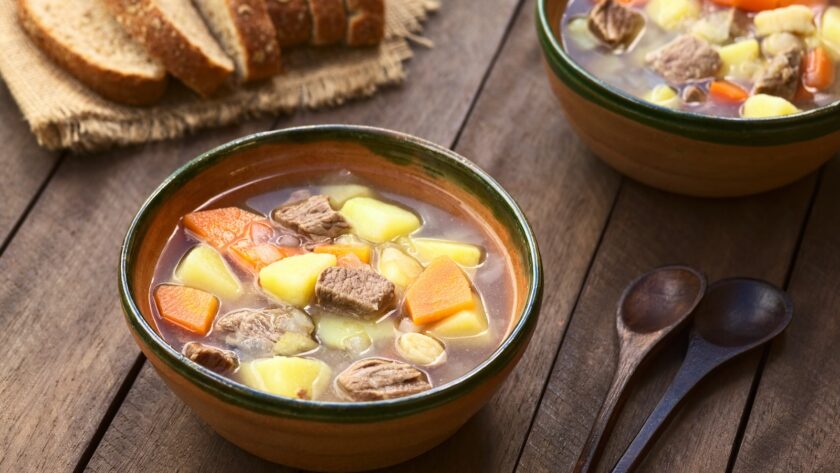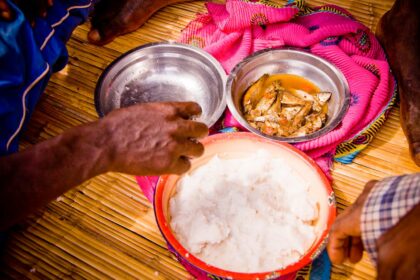
I believe one of the strongest types of memory is the memory of taste. Who hasn’t had a dish that directly associates to a time, a place or an event? My fondest taste-memory is of my mother’s Hungarian Gulyás, a hearty beef stew that warms me up from the inside out and takes me back to my childhood.
Gulyás, pronounced “Goul-yash,” is a traditional Hungarian stew that migrated from my grandmother’s table in Hungary, to her family’s table in Chicago, Illinois, to my family’s table today in Elgin, Illinois. I never knew my grandmother before she passed, but I’ve met her through the family recipes I’ve been taught. I’ve grown to know a culture and cuisine I would not have known without her cooking.
Growing up, I was surrounded by other children. My mother ran an at-home daycare service, so I learned from the age of four to always share because, well, I really didn’t have a choice.
This included sharing my mother’s home cooking.

As summer tapered to an end and autumn descended, Mom would serve her house full of children the same Gulyás that her mother served her when she was a child. During October, Mom would call it “Ghoul-yash” in honor of Halloween and serve it over noodles shaped like Jack-o-lanterns. The sweet and peppery stew was perfect for multiple hungry bellies (my grandmother had to feed five children with this recipe, herself).
Originating from 18th century Hunagrian farmers’ tables, Gulyás is one of the few dishes that has traveled through time, while maintaining its traditional composure. Although some recipes vary in ingredients, whoever is cooking is likely to tell you their version of Gulyás is the true way to make it. Melt-in-your-mouth-good, this dish is the ultimate comfort food that serves up an intense dosage of nostalgia and happiness.

Hunagrian Gulyás
Serves: up to 6
Ingredients:
ο Stewing beef- 2 lbs., cut into 1 inch pieces
ο Butter- 2 TB
ο Medium yellow onion- 1 whole, diced
ο Fresh garlic- _ TB, minced
ο Beef broth- 1 _ cups + up to additional 1 cup during cooking
ο Tomato sauce- 8 oz.
ο Tomato paste- 4 oz.
ο Worcestershire sauce- 2 TB
ο Brown sugar- 1 TB
ο Hungarian Paprika- 3 TB
ο Mustard powder- _ tsp.
ο Cayenne pepper- _ tsp.
ο Salt & Pepper- to taste
ο Sour cream- 2 TB + additional for garnish
Steps:
1. In a large pot, melt the butter over medium heat. Add the stewing beef, and cook until browned.
2. Add the diced onion and minced garlic to the pot. Continually stir, and cook the ingredients until the onions become slightly transparent.
3. To the pot, add the first amount of beef broth, the tomato sauce, tomato paste, Worcestershire sauce and brown sugar. Stir together.
4. Cover the pot. Turn the stove to high heat and cook the ingredients until boiling. Allow the stew to boil for about one minute. Remove the lid, stir all the ingredients, and turn the heat down to medium-low.
5. Add the paprika, mustard powder and cayenne pepper. Mix together, then salt and pepper the stew to taste.
6. Return the lid to the pot, and allow the stew to simmer for up to 2 hours while intermittently stirring. Add additional beef broth if too much liquid evaporates. Look for a saucy texture that is not too thick, but not too thin like soup.
7. When the stew has finished cooking, remove the pot from the heat. Remove 1 cup of liquid from the pot, and stir in 2 TB of sour cream. Return the thickened liquid to the main stew, and stir together.
8. Serve the Gulyás over traditional nokedli (a Hungarian noodle), potatoes or buttered noodles. Garnish each plate with a dollop of sour cream.

About The Author
Jessica Lewandowski is a professional cake decorator and aspiring writer/blogger. She hopes to find a career that blends her love of food, writing and desire to travel. When she’s not contributing to her blog, Paprikás, Jessica is finding other ways to immerse herself in culture by cooking, flipping through travel magazines or reading. You can visit her blog at paprikasfoodblog.wordpress.com.
Jessica Festa
Latest posts by Jessica Festa (see all)
- A Culturally-Immersive Adventure In Mongolia’s Altai Mountains - Jul 8, 2023
- This Recipe Sharing Platform Supports Women In The Culinary Industry (Labneh Recipe Included!) - Nov 5, 2020
- Hiking The Mohare Danda Community Eco-Trek In Nepal - Jun 3, 2020
- 6 Important Questions For Choosing A Responsible Yoga Retreat - May 18, 2020
- How To Create & Grow A Profitable Blogging Business (Ethically) - Jan 18, 2020





Very proud of you, Jessica. Mary, thank you for raising such a graceful young lady.
@Helen: This was actually a guest post, but thank you 🙂